Dudák
- Introduction
- Players and Cards
- The Deal
- The Play
- The Endgame
- Variations
- Open Dudák (Otevřený Dudák)
- Pocket Dudák (Kapsičkový Dudák)
- Secret Dudák (Tajný Dudák)
- Dudák with a Talon (Lízaný Dudák)
- Two or Three Players
Introduction
This Czech game belongs to the same family as the famous Russian game Durak, and that is maybe how it acquired its similar sounding name Dudák, which actually means "bagpiper". It was popular in the mid twentieth century but is perhaps less well-known nowadays.
As in all games of this group, the object is to get rid of one's cards, the loser being the last player holding cards when the others have run out. To get rid of cards one has to be able to beat the card previously played, either with a high card of the same suit or with a trump. An unusual feature of the game is that (as in the related Russian game Svoi Kozyri), every player has his or her own trump suit.
This page is based on several sources, including the book Oficiální Pravidla Karetních Her by Tomáš Svoboda et al., and correspondence with Richard Heli, Jaroslav Mikovec, Alexey Lobashev, Zbyněk Hartmann and others.
Players and Cards
Dudák is best for four players, and this version will be described first. It is also possible for two or three people to play.
A German suited 32-card pack used. The suits are acorns (žaludy), leaves (zelené - green), hearts (červené - red) and balls (kule) and the cards in each suit, from high to low, are ace (eso), king (král), over (svršek or filek), under (spodek), 10 (deset), 9 (devět), 8 (osm), 7 (sedm). Generally, cards of the Bohemian pattern are used. In this design, illustrated below, the aces have two suit symbols at the top, the kings are seated and also have two suit symbols, the overs have one suit symbol at the top, the unders one suit symbol at the bottom of the card, and the numeral cards are identified by the number of symbols. The tens also have a roman number X.

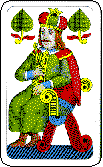

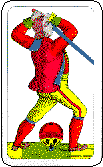
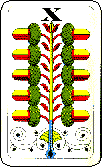
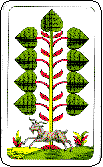
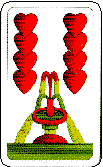
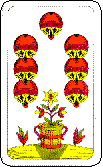
If these cards are not available, it is possible, though less authentic, to play with another German suited card pattern or even with 32 cards from a standard international pack.
The Deal
The cards are dealt out equally to the four players, so that each has eight cards. Any player may deal the first hand, and subsequently the loser of each hand deals the next.
The Play
Play is clockwise, beginning with the player to the left of the dealer. Cards are played from hand onto a face up play pile in the centre of the table. At the start of the play, the play pile is empty, and the first play plays one card. Subsequent players beat the top card of the pile (with a higher card of the same suit or a trump - see below) and then play a second card of their choice. In this way the play pile grows until someone is unable to or does not wish to beat the second card played by their predecessor. In this case they must pick up cards from the pile, according to the rules below. If a player picks up all the cards from the pile, the turn passes to the next player, who may play any card to start a new pile.
At the beginning of any turn, a player may declare a trump suit. From the remainder of this deal, the player may use any card of this suit to beat any card of another suit. It is not allowed for more than one player to have the same trump suit, so players may only declare a suit that has not already been declared by another player. When three players have declared trumps, the fourth suit automatically becomes trumps for the fourth player. A player's trump suit, once declared, cannot be changed until the following deal.
The rules of play are as follows:
- If the play pile is empty, a turn consists of playing any one card from hand to the table to start a new pile.
- If the play pile is not empty, and the player has not yet declared trumps, the player may either
- beat the top card of the pile with a higher card of the same suit and play a second card, which may be any card from the player's hand, or
- remove cards one at a time from the top of the pile until a card is exposed which the player is able and willing to beat with a higher card of the same suit from hand. After beating this card, the player adds the cards removed from the play pile to his or her hand, and plays a second card on the play pile, which can be any card, including one of the cards just acquired from the play pile.
- continue removing cards from the play pile until it is empty. In this case the cards taken from the pile are added to the player's hand. A player who empties the pile does not play a card, and the turn passes to the next player.
- If the play pile is not empty and the player has already declared a trump suit, the player may either
- beat the top card of the pile with a higher card of the same suit or any card of the player's own trump suit and then play a second card (any card), or
- pick up the whole play pile and play no cards. In this case the turn passes to the next player, who may play any card to the empty table.
The Endgame
A player who runs of cards drops out of the play, and the others continue playing until only one player has cards. This player is the loser.
If a player has only one card left in hand, and uses it to beat the top card of the pile, the whole play pile is discarded from the game and not used again until the next deal. The next player may play any card to begin a new pile. This procedure is known as vejbit or abštych.
Variations
It seems that there are several slight variations in the play. However, since several published descriptions of this game are unclear or ambiguous, it may be that some of these are mistakes rather than versions of the game that are actually played.
Apparently some play that if you have not yet declared trumps, then if you pick up the top card of the play pile you must also pick up any cards of the same suit that are immediately under it, and continue until you find a card of a different suit (or the pile is empty). When a new suit appears you may beat this card, or pick it up together with all the cards of the same suit that follow it until another suit is found, and so on.
Also, it seems that some play that even after declaring trumps, it is possible to pick up cards from the pile one at a time, in the same way as before trumps are declared.
Some play that trumps can be declared not only at the start of a player's turn, but at any time during the process of picking up cards.
Open Dudák (Otevřený Dudák)
In this variation, each player's trump suit is decided in advance and known to all players. Normally the players keep the same suits for the whole session. They may simply agree at the start who will have which suit, or it can be decided by the first deal as follows. Before the players look at their cards, the first card from the first player's hand is turned face up. This determines the first player's trump suit. Then a card is turned up from the second player's hand, and if it is the same suit as the first player's trump, further cards are turned up until a second suit appears. This is the second player's trump suit. Then cards are turned up from the third player's hand until a new suit appears, which is the third player's trump suit. Finally the fourth player takes the fourth suit. If a player's whole hand is exposed without any new suit appearing, the player chooses a suit from among those not already assigned.
Since the trump suits are known from the start, the rules that apply after trumps have been declared should apply throughout: a player who cannot or does not wish to beat the top card of the play pile must pick up the whole pile, and the turn passes to the next player.
Pocket Dudák (Kapsičkový Dudák)
In this version, each player is dealt a hand of cards plus a separate card which will determine the player's trump suit. For example in the four-player game without a talon, each player will have a hand of seven cards plus a trump card.
Players look at their hands and also at their own trump cards, but at the start no one reveals to anyone else what their trump suit is. The trump cards are kept face down on the table in front of the players. The play is as in the basic game, except that when a player wishes to declare trumps, this is done by turning one's trump card face up and then adding it to one's hand (or playing it). It is not possible to pick up or play one's trump card without declaring one's trump suit.
Note that in this game, it is possible for two or more players to have the same trump suit.
Dudák with a Talon (Lízaný Dudák)
Several accounts, especially older ones, describe a version of Dudák where not all the cards are dealt out. Instead a limited number of cards (for example five cards) are dealt to each player initially, and the remainder are stacked face down to form a talon.
In this game, after each turn, if a player has fewer cards in hand than were originally dealt, the player's hand must be replenished by drawing cards from the talon until it contains the original number again. For example if five cards each are dealt, the first player will play a card and draw one. Then if the second player beats the first player's card and plays another card, she will end her turn by drawing two cards to bring her hand back to five cards. This will continue, with each player playing two cards and drawing two until someone cannot or does not wish to beat the top card.
A player who cannot or chooses not to beat the top card of the play pile must draw card from the talon. The player continues drawing until either able and willing to beat the top card of the play pile, or until there are no more cards in the talon.
When the talon is empty, the game continues in the same way as Dudák without a talon, in which the alternative to beating the top card of the play pile is to pick up cards from the play pile.
One book (Miloš Zapletal: Velka Encyclopedie Her) gives a version in which only two cards each are dealt initially. As usual, at your turn you may beat the top card with a card from your hand or draw cards from the talon until you find a card that you are willing to play to beat the top card. After beating the top card you play a second card, which may be any card from your hand. If the talon is empty and you cannot or do not want to beat the top card you must pick up the whole play pile. A player who has fewer than two cards in hand after playing draws cards from the talon until he or she has two.
Secret Dudák (Tajný Dudák)
This game is exactly like Pocket Dudák (above) except no one is allowed to see the players' trump cards. Each of these cards remain face down in front of its owner and unknown to all until the owner chooses to declare trumps and turns the card face up.
Some play that when declaring trumps you may take any of the trump cards that remain face down and reveal it (not necessarily the one that was dealt in front of you). This should make no difference to the game, since no one is supposed to know what these cards are until they are revealed.
Two or Three Players
Any of the variants can be played, and the rules are the same as with four players. With two players, it is probably best to play with a talon, otherwise the initial hands will be very large and the players will know each others' cards. With three players, if there is no talon, two sevens are removed to leave a 30-card pack, and 10 cards (or 9 cards plus one trump card) are dealt to each player.